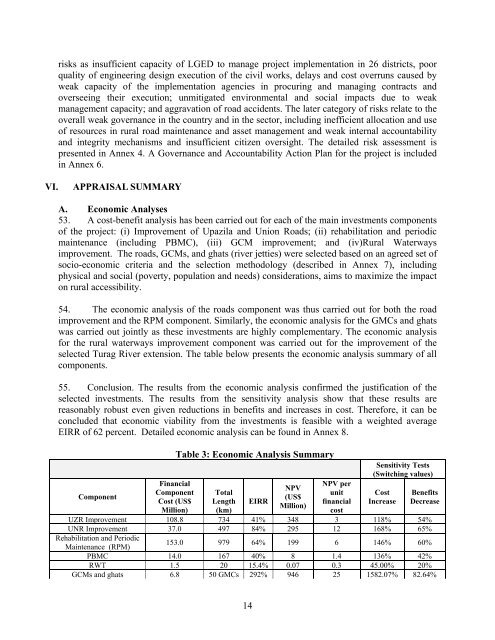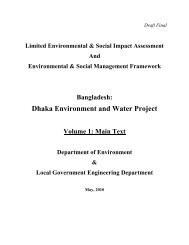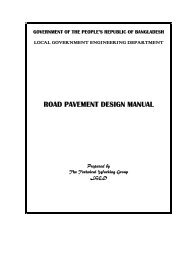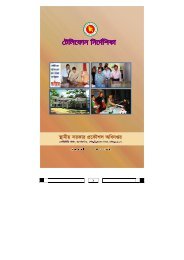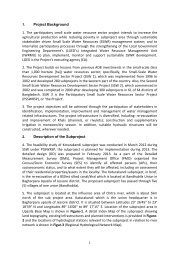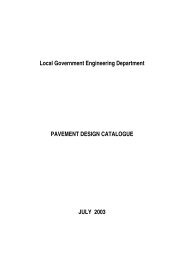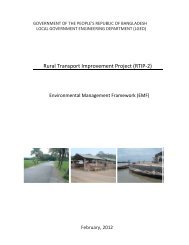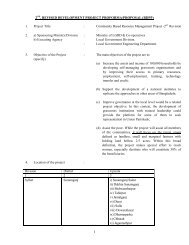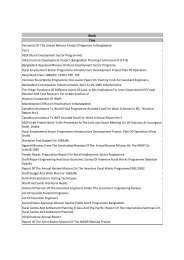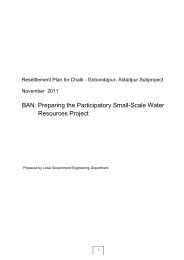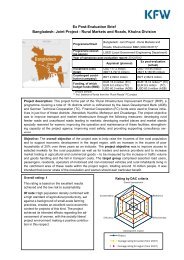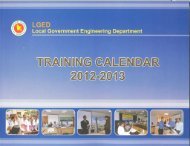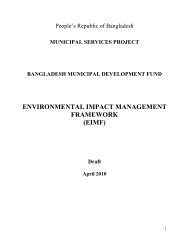PAD - LGED
PAD - LGED
PAD - LGED
Create successful ePaper yourself
Turn your PDF publications into a flip-book with our unique Google optimized e-Paper software.
isks as insufficient capacity of <strong>LGED</strong> to manage project implementation in 26 districts, poor<br />
quality of engineering design execution of the civil works, delays and cost overruns caused by<br />
weak capacity of the implementation agencies in procuring and managing contracts and<br />
overseeing their execution; unmitigated environmental and social impacts due to weak<br />
management capacity; and aggravation of road accidents. The later category of risks relate to the<br />
overall weak governance in the country and in the sector, including inefficient allocation and use<br />
of resources in rural road maintenance and asset management and weak internal accountability<br />
and integrity mechanisms and insufficient citizen oversight. The detailed risk assessment is<br />
presented in Annex 4. A Governance and Accountability Action Plan for the project is included<br />
in Annex 6.<br />
VI.<br />
APPRAISAL SUMMARY<br />
A. Economic Analyses<br />
53. A cost-benefit analysis has been carried out for each of the main investments components<br />
of the project: (i) Improvement of Upazila and Union Roads; (ii) rehabilitation and periodic<br />
maintenance (including PBMC), (iii) GCM improvement; and (iv)Rural Waterways<br />
improvement. The roads, GCMs, and ghats (river jetties) were selected based on an agreed set of<br />
socio-economic criteria and the selection methodology (described in Annex 7), including<br />
physical and social (poverty, population and needs) considerations, aims to maximize the impact<br />
on rural accessibility.<br />
54. The economic analysis of the roads component was thus carried out for both the road<br />
improvement and the RPM component. Similarly, the economic analysis for the GMCs and ghats<br />
was carried out jointly as these investments are highly complementary. The economic analysis<br />
for the rural waterways improvement component was carried out for the improvement of the<br />
selected Turag River extension. The table below presents the economic analysis summary of all<br />
components.<br />
55. Conclusion. The results from the economic analysis confirmed the justification of the<br />
selected investments. The results from the sensitivity analysis show that these results are<br />
reasonably robust even given reductions in benefits and increases in cost. Therefore, it can be<br />
concluded that economic viability from the investments is feasible with a weighted average<br />
EIRR of 62 percent. Detailed economic analysis can be found in Annex 8.<br />
Component<br />
Financial<br />
Component<br />
Cost (US$<br />
Million)<br />
Table 3: Economic Analysis Summary<br />
Total<br />
Length<br />
(km)<br />
EIRR<br />
NPV<br />
(US$<br />
Million)<br />
NPV per<br />
unit<br />
financial<br />
cost<br />
Sensitivity Tests<br />
(Switching values)<br />
Cost<br />
Increase<br />
Benefits<br />
Decrease<br />
UZR Improvement 108.8 734 41% 348 3 118% 54%<br />
UNR Improvement 37.0 497 84% 295 12 168% 65%<br />
Rehabilitation and Periodic<br />
Maintenance (RPM)<br />
153.0 979 64% 199 6 146% 60%<br />
PBMC 14.0 167 40% 8 1.4 136% 42%<br />
RWT 1.5 20 15.4% 0.07 0.3 45.00% 20%<br />
GCMs and ghats 6.8 50 GMCs 292% 946 25 1582.07% 82.64%<br />
14


